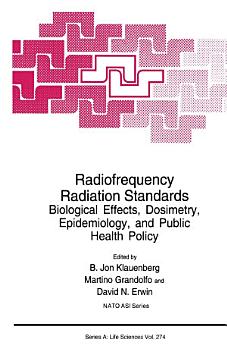Radiofrequency Radiation Standards: Biological Effects, Dosimetry, Epidemiology, and Public Health Policy
B. Jon Klauenberg · Martino Grandolfo · David N. Erwin
nvb 2013 · NATO Science Series A Livre 274 · Springer Science & Business Media
5,0star
2 avisreport
E-book
456
Pages
reportLes notes et avis ne sont pas vérifiés. En savoir plus
À propos de cet e-book
The North Atlantic Treaty Organization (NATO) has sponsored research and personnel safety standards development for exposure to Radiofrequency Radiation (RFR) for over twenty years. The Aerospace Medical Panel of the Advisory Group For Aerospace Research and Development (AGARD) sponsored Lecture Series No. 78 Radiation Hazards,! in 1975, in the Netherlands, Germany, and Norway, on the subject of Radiation Hazards to provide a review and critical analysis of the available information and concepts. In the same year, Research Study Group 2 on Protection of Personnel Against Non-Ionizing Electromagnetic Radiation (Panel VIIl of AC/243 Defence Research Group, NATO) proposed a revision to Standardization Agreement (STANAG) 2345. The intent of the proposal was to revise the ST ANAG to incorporate frequency-dependent-RFR safety guidelines. These changes are documented in the NATO STANAG 2345 (MED), Control and Recording of Personnel Exposure to Radiofrequency Radiation,2 promulgated in 1979. Research Study Group 2 (RSG2) of NATO Defense Research Group Panel VIII (AC1243) was organized, in 1981, to study and contribute technical information concerning the protection of military personnel from the effects of radiofrequency electromagnetic radiation. A workshop at the Royal Air Force Institute of Aviation Medicine, Royal Aircraft Establishment, Farnborough, U. K. was held to develop and/or compile sufficient knowledge on the long-term effects of pulsed RFR to maintain safe procedures and to minimize unnecessary operational constraints.
Notes et avis
5,0
2 avis
Donner une note à cet e-book
Dites-nous ce que vous en pensez.
Informations sur la lecture
Smartphones et tablettes
Installez l'application Google Play Livres pour Android et iPad ou iPhone. Elle se synchronise automatiquement avec votre compte et vous permet de lire des livres en ligne ou hors connexion, où que vous soyez.
Ordinateurs portables et de bureau
Vous pouvez écouter les livres audio achetés sur Google Play à l'aide du navigateur Web de votre ordinateur.
Liseuses et autres appareils
Pour lire sur des appareils e-Ink, comme les liseuses Kobo, vous devez télécharger un fichier et le transférer sur l'appareil en question. Suivez les instructions détaillées du Centre d'aide pour transférer les fichiers sur les liseuses compatibles.







